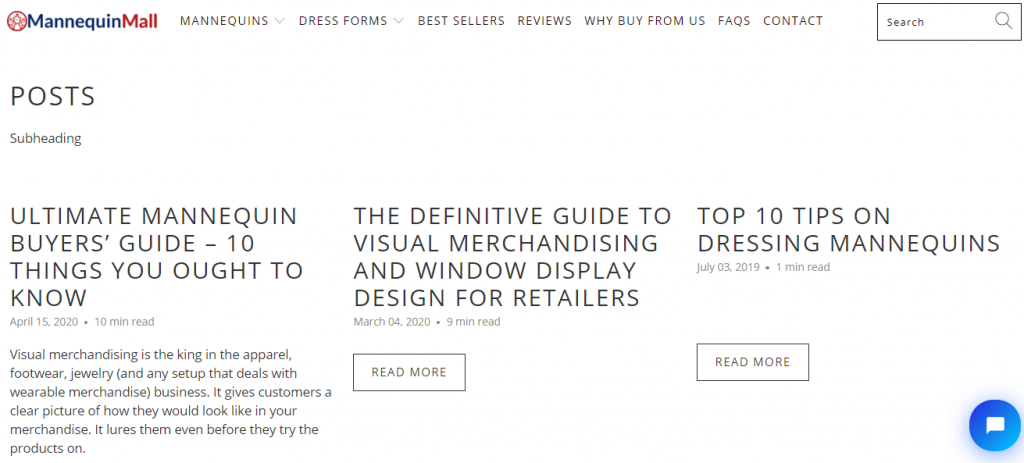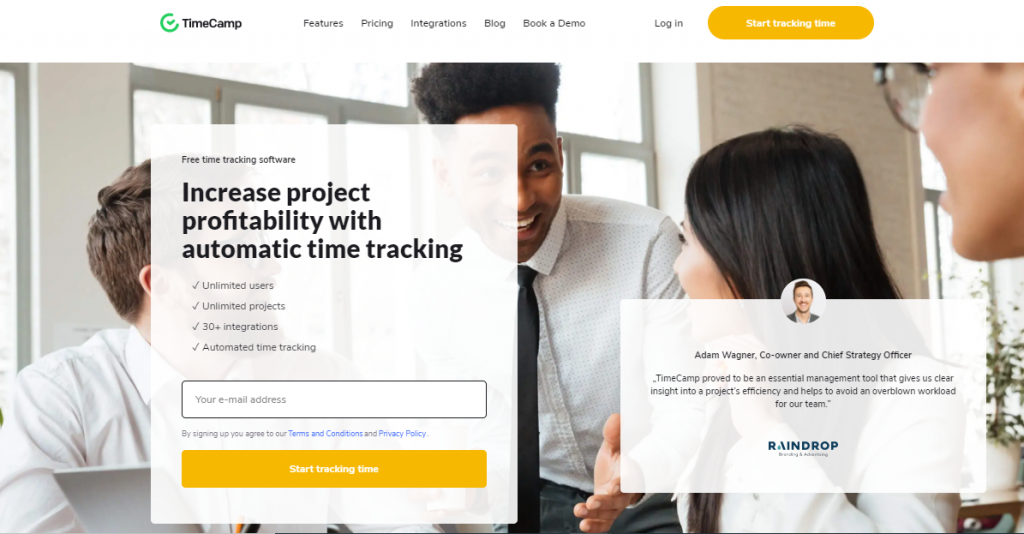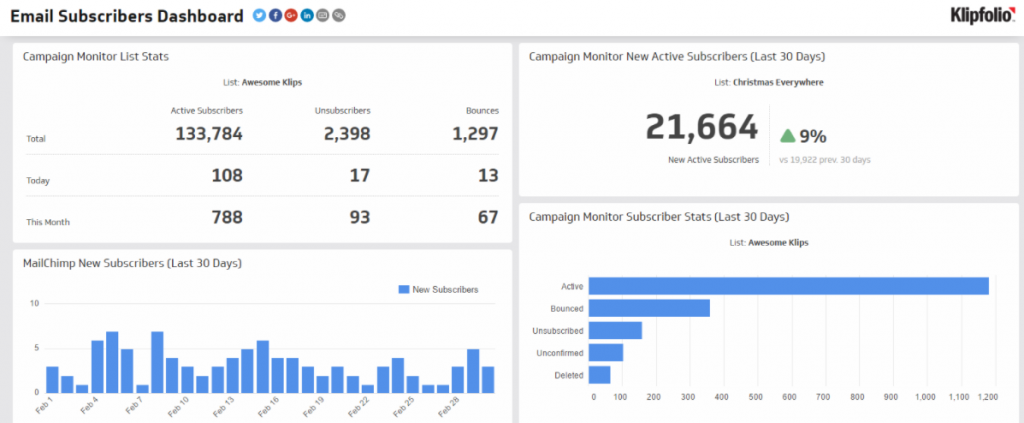- Products
- ProspectSQL/MQL list building with high levels of personalization, real-time data enrichment and prospect search
- Email FinderFind individual or bulk emails by entering the person & company name or domain
- Email VerifierVerify emails addresses individually, in bulk or through API, with 99% accuracy
- Clearout For SheetsVerify email addresses directly on Google Sheets with Clearout for sheets add-on
- ClearoutPhoneValidate phone numbers across 240+ countries in bulk, quick or real time validation Free Tools
- Disposable Email Checker
- Reverse LinkedIn Profile Lookup Tool
- Reverse Email Lookup Tool
- Email List Cleaner
- Resource
- Pricing
- Integrations
- Enterprise
- Login
Is It Possible To Create And Grow An Engaged Email List?
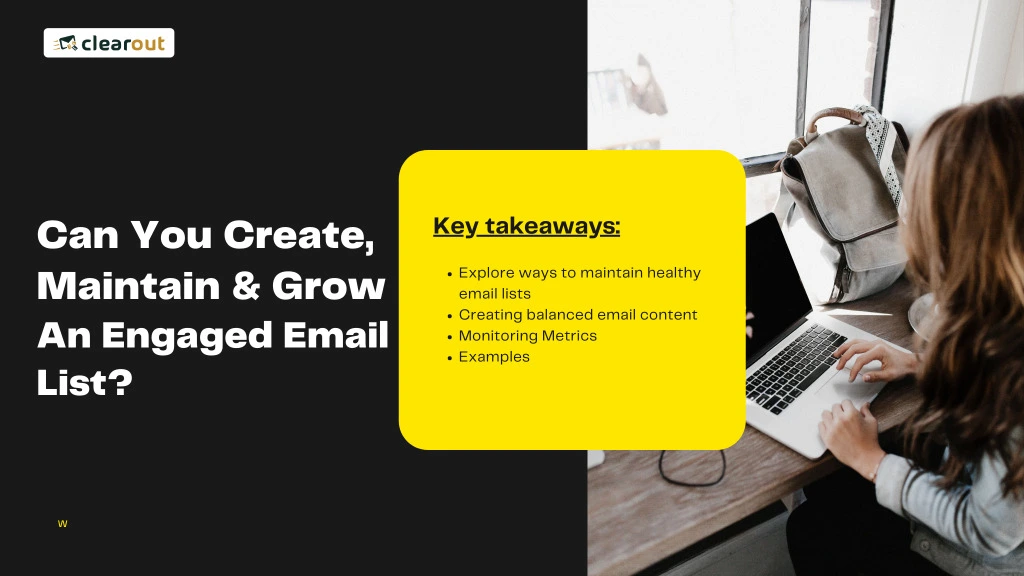
If you’re not getting your desired email marketing results, one main culprit could be your email list.
In today’s era of email marketing, it’s not about how big your email list is but it should be how engaged they are in what you have to say.
An engaged email list is the backbone of every successful email campaign. If people don’t want to read your emails, your marketing efforts will never convert and hit your targets.
So in this post, we’ll be talking about how you can create an engaged email list and nurture it to grow even bigger.
An engaged email list is the backbone of every successful email campaign. If people don’t want to read your emails, your marketing efforts will never convert and hit your targets.
So in this post, we’ll be talking about how you can create an engaged email list and nurture it to grow even bigger.
How To Create An Engaged Email List?
1. Build your email list with ideal prospects only
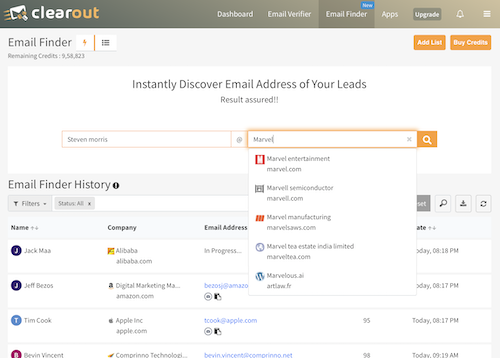
Email addresses are the keys that unlock the gates to limitless chances. However, finding email addresses can take some time. This is because, unlike their website URLs or social media handles, few people freely share their email addresses.
As emails are so powerful and frequently used, many tools make it simple to hunt for your prospects' email addresses. One can approach this process in a variety of ways. Numerous tools and strategies have been divided into three sections to make them easier to comprehend and implement:
Basic search: Eg Google. Twitter
Plugins and extensions: Chrome extensions like LeadGibbon, Clearbit Sheets
Web-based applications: Automated email finders that work individually or integrate with your software/ any tool in use. Like Clearout email finder, Toofr, etc.
Creating lists with these tools ensure that you don't have to struggle to convince people about the value of your product.
As emails are so powerful and frequently used, many tools make it simple to hunt for your prospects' email addresses. One can approach this process in a variety of ways. Numerous tools and strategies have been divided into three sections to make them easier to comprehend and implement:
Creating lists with these tools ensure that you don't have to struggle to convince people about the value of your product.

2. Maintain a healthy email list

When you’ve been in email marketing for quite some time, you know that the initial email list you’ve built won’t be as active as it once was. You’ll see your conversion rate and engagement slowly decline.
This happens because of email list decay. It’s a condition wherein your previous subscribers are now unsubscribed from your email list.
In order to keep an engaged email list, you need to monitor and take out the inactive email addresses. These emails can be where your emails bounced or those who didn’t bother to open them in the first place.
Now, this might slash your email list close to 50% or more but remember, when trying to achieve an engaged email list, quality is more important than quantity.
As the saying goes "A small list that wants exactly what you’re offering is better than a bigger list that isn’t committed”
To make the process of maintaining a healthy email list easier, you can use an email verification tool. These tools are designed to help users reduce the number of undelivered messages.
Email verification tools help in verifying whether an email address is active, inactive, or fake. With the help of such tools, businesses can filter active emails from inactive ones. This gives them a lower bounce rate and higher deliverability.
This happens because of email list decay. It’s a condition wherein your previous subscribers are now unsubscribed from your email list.
In order to keep an engaged email list, you need to monitor and take out the inactive email addresses. These emails can be where your emails bounced or those who didn’t bother to open them in the first place.
Now, this might slash your email list close to 50% or more but remember, when trying to achieve an engaged email list, quality is more important than quantity.
As the saying goes "A small list that wants exactly what you’re offering is better than a bigger list that isn’t committed”
To make the process of maintaining a healthy email list easier, you can use an email verification tool. These tools are designed to help users reduce the number of undelivered messages.
Email verification tools help in verifying whether an email address is active, inactive, or fake. With the help of such tools, businesses can filter active emails from inactive ones. This gives them a lower bounce rate and higher deliverability.

3. Segment your email list

If you haven’t tried to segment your email list yet, then you’re missing out on a lot of opportunities. The reason for segmentation is to counter the one size fits all marketing strategy.
You need to understand that not everyone on your list wants to read your promotion, your referral program, or your newsletter. Some are just in it for your content while others are waiting for your discounts.
If you’re able to segment your email list, your emails sent will be more effective. By segmenting, you get to send the proper emails to your list - making them more engaged with your campaign and business.
To segment an email list, you can use the “tags” feature of your email software. Tags are used to organize your list.
For example, your business could be in financial services. You could have clients who are focused on traditional investments, cryptocurrencies, or the DeFi-NFT space. Rather than sending out a mass email that’s too general, you can segment your clients into different financial instruments that they like.
With a segmented list, you get to distribute your content or marketing campaigns to the right people. Once you present the right type of email content to the correct set of groups, you’ll eventually see your engagement and conversion rate go up.
You need to understand that not everyone on your list wants to read your promotion, your referral program, or your newsletter. Some are just in it for your content while others are waiting for your discounts.
If you’re able to segment your email list, your emails sent will be more effective. By segmenting, you get to send the proper emails to your list - making them more engaged with your campaign and business.
To segment an email list, you can use the “tags” feature of your email software. Tags are used to organize your list.
For example, your business could be in financial services. You could have clients who are focused on traditional investments, cryptocurrencies, or the DeFi-NFT space. Rather than sending out a mass email that’s too general, you can segment your clients into different financial instruments that they like.
With a segmented list, you get to distribute your content or marketing campaigns to the right people. Once you present the right type of email content to the correct set of groups, you’ll eventually see your engagement and conversion rate go up.
4. Opt-ins are important
By definition, opt-in means to choose or to be involved in something. This means that when a customer opts-in, they are aware that they’ll be part of your email list and will be receiving content and promotions from you.
When creating an engaged email list, you want it to be through opt-in. In this way, you know that those email addresses want to read what you have to say.
This approach is what we call permission-based marketing. This is opposed to buying emails just to have a big email list to send your campaigns to. Buying a set of emails will never benefit a business.
When consumers receive unsolicited emails, they are quick to put them to spam or the virtual trash bin. With the number of cybersecurity issues, people are extra cautious in opening up random emails.
So make sure to utilize opt-ins and do your best to deliver on your end. The last thing you want to do is to disappoint your list of people who are interested in what you have to say.
When creating an engaged email list, you want it to be through opt-in. In this way, you know that those email addresses want to read what you have to say.
This approach is what we call permission-based marketing. This is opposed to buying emails just to have a big email list to send your campaigns to. Buying a set of emails will never benefit a business.
When consumers receive unsolicited emails, they are quick to put them to spam or the virtual trash bin. With the number of cybersecurity issues, people are extra cautious in opening up random emails.
So make sure to utilize opt-ins and do your best to deliver on your end. The last thing you want to do is to disappoint your list of people who are interested in what you have to say.
5. Use signup forms
Creating an email sign-up form is another excellent way for you to build up an engaged email list. An email sign-up form is used to collect email addresses from website visitors.
These forms usually pop up when a web visitor is on a certain page of a website. Remember the times when a pop-up appeared on your screen when you were looking at websites? Do you also remember how fast you were looking for the “x” icon to close the form?
That experience is not yours alone - millions of people do that as well. This just means that signup forms will never get filled if a person is uninterested - they’re just going to close that form immediately.
So if a customer or a web visitor does take time out of their day to fill in that form and give you their email, then you know that person is interested and willing to hear from you.
Given how fast a customer can close a signup form, there’s actual “science” behind it for it to convert. Website owners and marketers only have a few seconds to capture the attention of their customers.
Now how a signup form should look can be an article of its own. Instead, I’ll list down the different elements that should be present on your form.
Name - A full name could be an option but some would be hesitant to give their full name online. So a first name would do. You need a name for personalization purposes.
Email address - Getting their email address should be one of your objectives for obvious reasons.
What you have to offer - For them to give you their details, they need to know what you have to offer. Are you going to send them exclusive discounts? A free eBook? An all-access to an online live event? Incentives matter and it increases the likelihood of signup.
PRO TIP: If you're hosting an online event, make sure to check out this article for some event invitation email inspiration. The best event emails have to be clear enough for the potential attendants to easily see what the event is about and decide if it's something they'd like to be a part of.
Below you can see how Key West Aloe incentives its web visitors via a point system and vouchers:
These forms usually pop up when a web visitor is on a certain page of a website. Remember the times when a pop-up appeared on your screen when you were looking at websites? Do you also remember how fast you were looking for the “x” icon to close the form?
That experience is not yours alone - millions of people do that as well. This just means that signup forms will never get filled if a person is uninterested - they’re just going to close that form immediately.
So if a customer or a web visitor does take time out of their day to fill in that form and give you their email, then you know that person is interested and willing to hear from you.
Given how fast a customer can close a signup form, there’s actual “science” behind it for it to convert. Website owners and marketers only have a few seconds to capture the attention of their customers.
Now how a signup form should look can be an article of its own. Instead, I’ll list down the different elements that should be present on your form.
Name - A full name could be an option but some would be hesitant to give their full name online. So a first name would do. You need a name for personalization purposes.
Email address - Getting their email address should be one of your objectives for obvious reasons.
What you have to offer - For them to give you their details, they need to know what you have to offer. Are you going to send them exclusive discounts? A free eBook? An all-access to an online live event? Incentives matter and it increases the likelihood of signup.
PRO TIP: If you're hosting an online event, make sure to check out this article for some event invitation email inspiration. The best event emails have to be clear enough for the potential attendants to easily see what the event is about and decide if it's something they'd like to be a part of.
Below you can see how Key West Aloe incentives its web visitors via a point system and vouchers:

What type of emails are you going to send - Other than the incentives, you should also state what value will they get by being part of your email list.
Take 3 Wishes as an example. Having a lot of products to sell like lingerie and costumes, an email address and a discount offer are enough to hook their audience to sign up to their list.
6. Create valuable content
Content creation has been the go-to medium of any marketing endeavor. Whether you’re doing Saas marketing, content marketing, or video marketing, your content will always be the deciding factor if it speaks to your audience.
Creating valuable content will help you increase your business’s visibility, improve marketing metrics and help with business growth.
The same thing goes when you want to create an engaged email list. Creating valuable content that speaks to your business will attract customers who are interested in what you do.
Creating valuable content will help you increase your business’s visibility, improve marketing metrics and help with business growth.
The same thing goes when you want to create an engaged email list. Creating valuable content that speaks to your business will attract customers who are interested in what you do.
Take a look at Mannequin Mall. Even though they just sell mannequins, they also make an effort in educating people in their niche through their blogs. So rather than just plainly selling, the company takes time to teach their audience as well.
How To Grow An Engaged Email List?
After creating and collecting an engaged email list, it’s important to know how you can nourish that list and grow it. Just because you have 50 engaged email addresses means you should stop there. Always strive to grow the quantity of your quality list while still aiming for engaged people.
So to help you with this, here are 4 ways to do so:
So to help you with this, here are 4 ways to do so:
I. Personalized emails
Personalization has worked wonders for many facets of marketing. Sales teams that use predictive dialers or any form of medium to sell use personalization as a technique to engage their client.
It has proven to be an important factor when it comes to any marketing campaign done by businesses. It’s even considered by many as a growth hacking strategy.
In email marketing, there is a lot of data that shows personalization can benefit a business. It’s proven that it can increase the open rate, give out a higher customer engagement, and can improve the transaction rate.
How do you personalize emails?
That’s where getting the name of your customer and segmentation comes in. Let’s discuss the name aspect first.
Although addressing your clients with their names may seem like a small detail in the grand scheme of things, it still adds to a great customer experience. It will seem like that you’re talking specifically to them - and this is the exact feeling you want to convey.
For segmentation, that is where the tags mentioned earlier are put to use.
When you’re planning to email the “Promotional Group”, you know exactly how to structure email content to bring attention to it.
The same goes if you’re targeting the “Content Marketing Group”, you know how to switch things up from the subject line to the body of the email to make sure you bring value to these people.
It has proven to be an important factor when it comes to any marketing campaign done by businesses. It’s even considered by many as a growth hacking strategy.
In email marketing, there is a lot of data that shows personalization can benefit a business. It’s proven that it can increase the open rate, give out a higher customer engagement, and can improve the transaction rate.
How do you personalize emails?
That’s where getting the name of your customer and segmentation comes in. Let’s discuss the name aspect first.
Although addressing your clients with their names may seem like a small detail in the grand scheme of things, it still adds to a great customer experience. It will seem like that you’re talking specifically to them - and this is the exact feeling you want to convey.
For segmentation, that is where the tags mentioned earlier are put to use.
When you’re planning to email the “Promotional Group”, you know exactly how to structure email content to bring attention to it.
The same goes if you’re targeting the “Content Marketing Group”, you know how to switch things up from the subject line to the body of the email to make sure you bring value to these people.
II. Balance your email content
When growing your business you don’t just keep producing promotional content. If you do this, your audience will see that converting is the only thing that matters to you.
The same logic is applied to your email list.
Being too focused on increasing sales and revenues will let marketers promote too much.
Remember, people joined your email list because of your content as well. If you keep sending them your restaurant promotions or any marketing campaign that doesn’t give them value, sooner or later they’re going to unsubscribe. That is why it is recommended to use restaurant email marketing tricks and strategies for better performance.
Great email marketers know how to balance informational emails with promotional ones. In fact, they can map this out and strategically use one type of email to compliment or set up the succeeding emails.
The same logic is applied to your email list.
Being too focused on increasing sales and revenues will let marketers promote too much.
Remember, people joined your email list because of your content as well. If you keep sending them your restaurant promotions or any marketing campaign that doesn’t give them value, sooner or later they’re going to unsubscribe. That is why it is recommended to use restaurant email marketing tricks and strategies for better performance.
Great email marketers know how to balance informational emails with promotional ones. In fact, they can map this out and strategically use one type of email to compliment or set up the succeeding emails.
Look at how Mixam switches its email up with promotional and educational intent:
III. Strategically position your signup forms
You just can’t post your signup forms anywhere. This too requires strategic thinking to increase the odds of your customers and prospects signing up. These are the usual place where the signup forms are placed:
Home page of a website - This is what we see from most businesses. A few seconds later on the homepage, a popup appears enticing us to sign up for their list.
In the case of TimeCamp - a free desktop time tracker, its signup form is just static on its home page.
Home page of a website - This is what we see from most businesses. A few seconds later on the homepage, a popup appears enticing us to sign up for their list.
In the case of TimeCamp - a free desktop time tracker, its signup form is just static on its home page.
Checkout page - This is the perfect page and time to invite your customer to join your mailing list. No better evidence that a customer is interested than the one who just recently purchased from you.
Product page - If a person is on your product page, there’s a good chance that your products or service has piqued his/her interest. It is also during this time that you can also show them an opt-in form for your email list.
If you’re not too savvy when it comes to customizing websites and web pages, you can always hire web designers to get the job done.
Product page - If a person is on your product page, there’s a good chance that your products or service has piqued his/her interest. It is also during this time that you can also show them an opt-in form for your email list.
If you’re not too savvy when it comes to customizing websites and web pages, you can always hire web designers to get the job done.
IV. Monitor your metrics closely
Metrics are important no matter if you sell in a physical store or do online trade like Amazon FBA business . Keeping track of metrics will always help you grow and improve something.
The same thing is applied to your email list. For you to keep growing your email list, you also need to be wary of how your emails are doing.
Check if your open rate has gone down for the week, observe if people are acting on your CTAs.
If this happens, go back to the drawing board. Analyze what changes you did in your content, what approach did you take.
By being on top of your email marketing, you get to make quick changes to continue engaging your audience.
Also, don’t forget to take note of what you did correct as well. Write down what content strategy you used for your email to have those impressive numbers. This will allow you to get ideas on what your market likes.
Check if your open rate has gone down for the week, observe if people are acting on your CTAs.
If this happens, go back to the drawing board. Analyze what changes you did in your content, what approach did you take.
By being on top of your email marketing, you get to make quick changes to continue engaging your audience.
Also, don’t forget to take note of what you did correct as well. Write down what content strategy you used for your email to have those impressive numbers. This will allow you to get ideas on what your market likes.
Why Do You Need An Engaged Email List?
As a business, you don’t want to spend money on an initiative where you can’t see any ROI. You want to make sure that your business endeavors will bring you exposure, sales, or anything that benefits a business.
And that’s what an email engaged list is achieving for a business. An engaged list is a way for a business to bring its customers and interested prospects into one channel. This saves the business time and effort knowing that their email marketing is going to the right people.
Once you present your content and marketing to the correct market, the higher the chance of converting a sale which ultimately helps business growth.
So are you ready to revamp your current email list and improve to an engaged one? By following the strategies and tips above, you’ll be achieving that in no time.
And that’s what an email engaged list is achieving for a business. An engaged list is a way for a business to bring its customers and interested prospects into one channel. This saves the business time and effort knowing that their email marketing is going to the right people.
Once you present your content and marketing to the correct market, the higher the chance of converting a sale which ultimately helps business growth.
So are you ready to revamp your current email list and improve to an engaged one? By following the strategies and tips above, you’ll be achieving that in no time.
Author Bio
Burkhard Berger is the founder of Novum. You can follow him on his journey from 0 to 100,000 monthly visitors on novumhq.com. His articles include some of the best growth hacking strategies and digital scaling tactics that he has learned from his own successes and failures.
Recent Posts
01 Jul 2025
Best Zoho CRM Integrations for Sales & Marketing in 2025
Discover the top Zoho CRM integrations in 2025 categorized by use case. Explore how each tool's key ...
01 Jul 2025
Sales Automation in 2025: The Guide to Close More Deals Faster
Struggling with manual sales workflows? Follow this guide to explore the sales automation use cases, ...
25 Jun 2025
Top 6 Email Finder APIs in 2025 for All Use Cases
Looking for a reliable Email Finder API? Explore the top 6 email finder APIs of 2025—compare key fea ...
17 Jun 2025
Top 10 Email Spam Checker Tools Tested & Reviewed (2025)
Check out the top 10 email spam checker tools to avoid junk folders. Compare features, ratings & use ...
06 Jun 2025
How To Create a Lead Magnet That Converts in 2025
Looking for more leads? Read how to create a high-converting lead magnet in 2025 with step-by-step g ...
Prospecting ,Email Finder & Email Verification Service
Prospecting ,Email Finder & Email Verification Service
Expand your reach by discovering and verifying the ideal prospects.
Sign up & get 100 free credits | No Credit Card required





